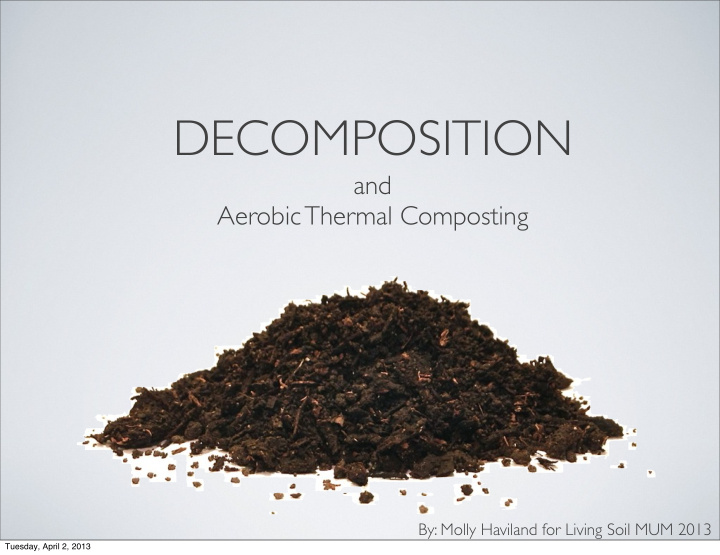



DECOMPOSITION and Aerobic Thermal Composting By: Molly Haviland for Living Soil MUM 2013 Tuesday, April 2, 2013
A BALANCED SYSTEM SUPPORTS 1. Soil Stabilization 2. Soil Aeration 3. Nutrient Retention 4. Nutrient Cycling 5. Water Retention 6. Plant Fertility 7. Carbon Sequestration Tuesday, April 2, 2013
WHAT IS COMPOSTING? Tuesday, April 2, 2013
WHAT IS COMPOSTING? “Composting is oxidative decomposition of a mix of different kinds of organic matter.” - Dr. Ingham Tuesday, April 2, 2013
OXIDATIVE Tuesday, April 2, 2013
OXIDATIVE “taking place in the presence of oxygen” AEROBIC “living with air” Anaerobic “living without air” Tuesday, April 2, 2013
TOXINS RELEASED Under Anaerobic Conditions • Hydrogen Sulfide: H2S • Ammonia: NH3 • Phosphine: PH3 • Alcohol • Phenols Tuesday, April 2, 2013
MONITORING O2 LEVELS • O2 Sensor • What Do You Smell? • Vinegar = Acetic Acid • Sour Milk = Butyric Acid • Vomit = Valeric Acid • Decaying Flesh = Putrescine Tuesday, April 2, 2013
DECOMPOSITION ? Tuesday, April 2, 2013
DECOMPOSITION ? “breaking down component parts and rebuilding them” Tuesday, April 2, 2013
DECOMPOSITION ? “breaking down component parts and rebuilding them” Tuesday, April 2, 2013
DIRT VS SOIL Mineral Component Life Component sand, silt, and clay + organisms and OM Tuesday, April 2, 2013
WHAT IS ORGANIC MATTER? Tuesday, April 2, 2013
WHAT IS ORGANIC MATTER? • Anything that was once living Tuesday, April 2, 2013
WHAT IS ORGANIC MATTER? • Anything that was once living • C-C linkages Tuesday, April 2, 2013
AEROBIC THERMAL COMPOSTING • Kills Pathogens and weed seeds • Finished in 2-4 Months • Stable Inoculum • Labor Intensive Tuesday, April 2, 2013
POINTS TO CONSIDER • Location • Size • Temperature • Moisture • Ingredient Ratios Tuesday, April 2, 2013
TEMPERATURE Organic Standards Require • At or above 131 F for 10-15 days • Turned 5 times within those days Tuesday, April 2, 2013
MOISTURE • Soil Moisture Meters • Hand Squeeze Method • Water Quality Tuesday, April 2, 2013
STARTING MATERIALS Tuesday, April 2, 2013
STARTING MATERIALS High Nitrogen 10:1 Tuesday, April 2, 2013
STARTING MATERIALS High Nitrogen 10:1 Green - Young 30:1 Tuesday, April 2, 2013
STARTING MATERIALS High Nitrogen 10:1 Green - Young 30:1 Woody - Mature 100:1 Tuesday, April 2, 2013
STARTING MATERIALS High Nitrogen 10:1 *Bacterial Food *Fresh Manure *Legumes *Nitrogen Fixing Plants Green - Young 30:1 Woody - Mature 100:1 Tuesday, April 2, 2013
STARTING MATERIALS High Nitrogen 10:1 *Bacterial Food *Fresh Manure *Legumes *Nitrogen Fixing Plants Green - Young 30:1 *Bacterial Food *Anything Cut Green Woody - Mature 100:1 Tuesday, April 2, 2013
STARTING MATERIALS High Nitrogen 10:1 *Bacterial Food *Fresh Manure *Legumes *Nitrogen Fixing Plants Green - Young 30:1 *Bacterial Food *Anything Cut Green Woody - Mature 100:1 *Fungal Food *Lignin/Cellulose Dense Tuesday, April 2, 2013
RECIPES Bacterial Pile Balanced Pile - 25% High Nitrogen - 25% High Nitrogen - 45% Green - Equal Parts Woody - 30% Woody and Green Fungal Pile Slow Fungal Pile - 25% High Nitrogen - 10% High Nitrogen - 45% Woody - 60% Woody - 30% Green - 30% Green Tuesday, April 2, 2013
HOMEWORK Read -Teaming with Microbes, by Lowenfels and Lewis (L&L): Preface through chapter 1 Char -Soil Biology Primer, by NRCS (SBP): The Soil Food Web -Syllabus : http://livingsoilsp2011.files.wordpress.com Create Blog - Post address as a comment on the Homepage of the Living Soil Blog - find one that will accept the microscope spread sheet in full Tuesday, April 2, 2013
Recommend
More recommend